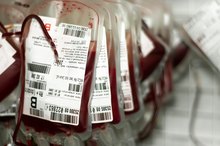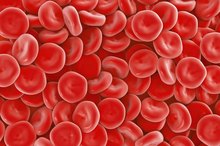What Causes a Low Blood Count?
Blood consists of protein-rich liquid and platelets, red blood cells and white blood cells, collectively known as formed blood elements. A complete blood count, or CBC, includes counts of the formed blood elements along with other measurements that help doctors interpret the test results. Many diseases and medical conditions can cause a low red blood cell, white blood cell or platelet counts.
Iron Deficiency
Iron deficiency is a leading cause of low red blood cell count among Americans. The bone marrow requires iron to produce red blood cells. When the body's iron stores fall to abnormally low levels, red blood cell production slows and anemia ensues. Iron deficiency develops due to inadequate dietary intake, blood loss or a combination of these factors. Women of childbearing age, infants, young children and people with medical conditions that cause blood loss have increased risk for iron deficiency and anemia.
- Iron deficiency is a leading cause of low red blood cell count among Americans.
Bleeding
What Are the Causes of Low Platelets & Low White Blood Cells?
Learn More
People with substantial ongoing or recent bleeding typically exhibit a low red blood cell count. Trauma proves a common cause of acute blood loss. Substantial bleeding also commonly occurs with digestive tract diseases and conditions, including blood vessel rupture associated with chronic liver disease, peptic ulcer disease, Crohn disease, hemorrhoids and cancerous and noncancerous tumors. Among women, menstrual disorders, pregnancy and related reproductive complications may cause significant blood loss, leading to a low blood count.
- People with substantial ongoing or recent bleeding typically exhibit a low red blood cell count.
- Among women, menstrual disorders, pregnancy and related reproductive complications may cause significant blood loss, leading to a low blood count.
Hereditary Hemolytic Anemias
Several hereditary blood disorders cause chronic or episodic destruction of the red blood cells, or hemolysis, leading to a low red blood cell count. These disorders -- known as hereditary hemolytic anemias -- include sickle cell disease, thalassemia, glucose-6-phosphate dehydrogenase deficiency, hereditary ovalocytosis and hereditary spherocytosis.
Infection
What Are the Causes of Low Platelets & Low White Blood Cells?
Learn More
Infections may cause a temporary decrease in white blood cell count, a condition known as leukopenia. In a severe bacterial infection, white blood cells that normally circulate in the bloodstream migrate to the site of the infection in large numbers, leading to a low white blood cell count in the blood. Leukopenia also occurs with certain viral infections, including those caused by influenza and hepatitis viruses, cytomegalovirus and Epstein-Barr virus.
Aplastic Anemia
Aplastic anemia is an uncommon condition characterized by profoundly decreased production of all formed elements of the blood. People with aplastic anemia -- also known as bone marrow failure -- have markedly low red blood cell, white blood cell and platelet counts. Inherited forms of aplastic anemia include Fanconi and Diamond-Blackfan anemias, dyskeratosis congenita and Shwachman-Diamond syndrome. Acquired causes of aplastic anemia include chemotherapy drugs, radiation therapy, benzene poisoning and HIV/AIDS. Aplastic anemia is also a rare complication of certain autoimmune disorders, including systemic lupus erythematosus and rheumatoid arthritis.
- Aplastic anemia is an uncommon condition characterized by profoundly decreased production of all formed elements of the blood.
- Inherited forms of aplastic anemia include Fanconi and Diamond-Blackfan anemias, dyskeratosis congenita and Shwachman-Diamond syndrome.
Related Articles
References
- Anemias and Other Red Cell Disorders; Kenneth Bridges and Howard A. Pearson
- Gastrointestinal Bleeding, Second Edition; Joseph Sung, et al.
- Differential Diagnosis in Internal Medicine: From Symptom to Diagnosis; Walter Siegenthaler
- Infectious Diseases, Third Edition; Sherwood L. Gorbach. et al.
- "Aplastic Anemia." About the Diseases. 10 Nov 2006. Aplastic Anemia & MDS International Foundation, Inc.
Writer Bio
Dr. Tina M. St. John owns and operates a health communications and consulting firm. She is also an accomplished medical writer and editor, and was formerly a senior medical officer with the U.S. Centers for Disease Control and Prevention. St. John holds an M.D. from Emory University School of Medicine.








